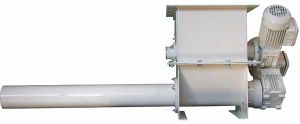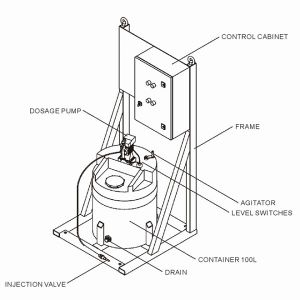Difference between revisions of "Dosing Units"
(Created page with "Category:Dosing{{Knoppen}} <noinclude><!------------------------------------------------ * READ THIS FIRST * Only edit this page if you can improve the content. * Improp...") |
|||
| (2 intermediate revisions by one other user not shown) | |||
| Line 1: | Line 1: | ||
[[Category:Dosing]]{{Knoppen}} | [[Category:Dosing]]{{Knoppen}} | ||
[[File:Dosing units.jpg|thumb|right|Dosing Units]] | |||
[[File:Dosing_Units_01.jpg|thumb|right|Dosing Units outline]] | |||
* | '''Dosing Units''' are the result of meticulous design work: maximum attention has been paid to ease of use and reliability. The control unit is based on a microprocessor, which makes programming very flexible, and a motorised screw controlled by inverter, thus ensuring high performance. An important feature of this equipment is the ability to directly set the dosing percentage. It does not require maintenance and offers long-term reliability. | ||
* | |||
==History== | |||
* 2006 – Ducane R&D Pty Ltd conceived the idea of a device that can store wastewater and release it in large batches to replace the drain clearing action of large volume toilet flushes. | |||
* 2010 – After much prototyping and development the devices are offered for sale in Australia, New Zealand and the United Kingdom under the name Drainwave. | |||
==Performance== | |||
Independent testing has shown that the use of an SDU allows for the use of low flush toilets using as little as 0.8 L to push general waste solids more than 25 metres along a typical wastewater drainpipe. One report showed that the maximum distance that a water saving 3 litre flush toilet can push solids was 10 metres after about 10 consecutive flushes, with the addition of an SDU this increased to about 20 metres on the first flush and past 25 metres with a second flush. | |||
An advantage of the SDU is that it can use more than just the toilet wastewater to clear the drains. This will keep drains clear of solids and prevent drainline blockages from occurring more effectuvely than. | |||
==Video== | |||
<youtube>H0UkUmzhydo</youtube> | |||
Latest revision as of 13:18, 3 October 2013
Dosing Units are the result of meticulous design work: maximum attention has been paid to ease of use and reliability. The control unit is based on a microprocessor, which makes programming very flexible, and a motorised screw controlled by inverter, thus ensuring high performance. An important feature of this equipment is the ability to directly set the dosing percentage. It does not require maintenance and offers long-term reliability.
History
- 2006 – Ducane R&D Pty Ltd conceived the idea of a device that can store wastewater and release it in large batches to replace the drain clearing action of large volume toilet flushes.
- 2010 – After much prototyping and development the devices are offered for sale in Australia, New Zealand and the United Kingdom under the name Drainwave.
Performance
Independent testing has shown that the use of an SDU allows for the use of low flush toilets using as little as 0.8 L to push general waste solids more than 25 metres along a typical wastewater drainpipe. One report showed that the maximum distance that a water saving 3 litre flush toilet can push solids was 10 metres after about 10 consecutive flushes, with the addition of an SDU this increased to about 20 metres on the first flush and past 25 metres with a second flush.
An advantage of the SDU is that it can use more than just the toilet wastewater to clear the drains. This will keep drains clear of solids and prevent drainline blockages from occurring more effectuvely than.
Video

